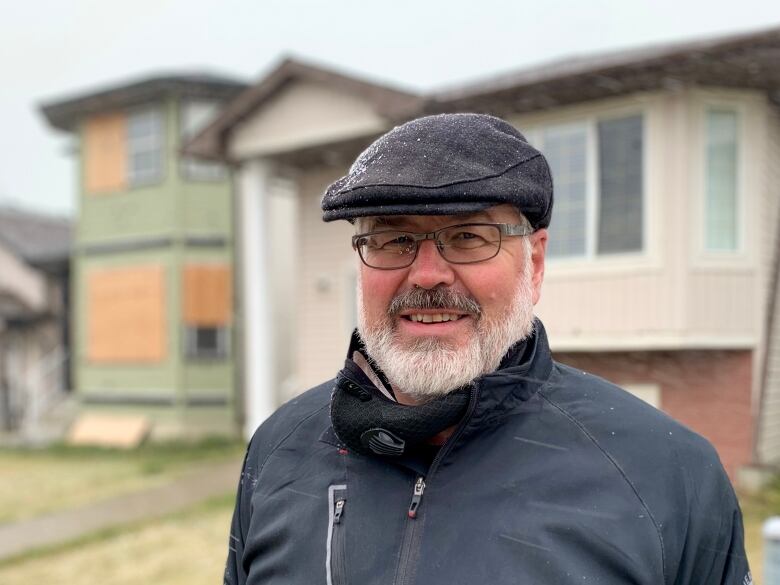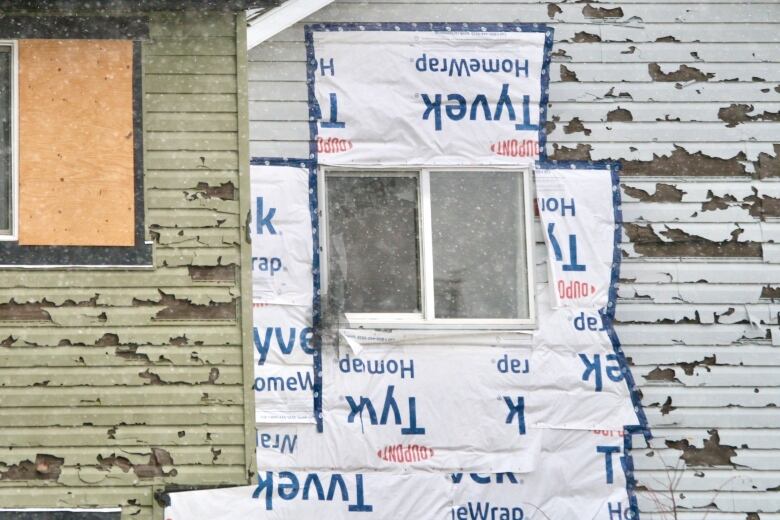Hail-ravaged northeast homes vulnerable to more damage as winter weather hits Calgary
Thousands of unrepaired homes are at risk, according to home expert

Thousands of northeast homes left with trashedsiding, broken windows and damagedroofs could be at risk of further damage if they're left unrepaired over the winter months, according to a Calgaryhome inspection expert.
Four months on from the violent summerhailstorm that caused $1.5 billionin property damage, less than half of the 70,000 insurance claims submitted have been resolved and thousands of homes are still far from being fixed. Many won't be.
Driving through the upper northeast of the city is still a shocking experience, with home after home, neighbourhood after neighbourhood,still sporting hail-ravagedsiding and boarded up windows.
There are some signs of progress but it's painfully slow and with winter closing in things could soon get worse for homeowners with unresolved damage.
"The siding is an integral part of the house, it works as a system," said Darcy McGregor, a home inspector in Calgary for more than 30 years.

"The siding protects the building envelope underneath it. The paper that's underneath keeps moisture from getting into the wood frame. Short-term exposure is OK,but not great, and insulation is quite resilient but it's not bullet proof and it will begin to break down," said McGregor.
He said with no siding, damage to the exposed barrier that sits underneath it could eventually cause serious problems.
"The first things would be a reduction in the R-value of your insulation and if it's long term or it doesn't dry you can eventually start getting rot and that's definitely something you don't want," said McGregor.
As well as siding peppered with golf ball-sized holes and cracks, some homes have siding that was stripped off altogether by the hail. Many have broken and boarded up windows in various stages of repair, which can also cause problems with the cold and moisture getting in.
"Boarding them up you can keep most of the water out but it really needs glass in there to do that properly," said McGregor.
"There's other things that happen. The exterior envelope is an air barrier and helps prevent air from moving through and carrying moisture and on the inside you have a vapour barrier preventing moisture from inside the house getting out but it also reduces the air flow. It does mess up the building science of the house when you're missing these components," McGregor said.

"Sooner or later, it's starting to get to the point where you could have some damage and if it goes through the winter you could end up with bigger problems."
McGregor said damaged roof shingles are less of an immediate issue, unless there are holes left behind from the hail that could cause leaks. He said some damaged roofs can still be good for a year.
As the snow falls, many residents are still working with their insurance companies and navigating the insurance system, not much further forward than they were in the summer months.
Some discovered their insurance policies aren't good enough to cover them. Others say they can't afford large deductibles or the repairs needed to fix or even protect their homes from further damage.
"Tarps don't look nice but if you can't afford repairs you have to do whatever you can to protect things as best you can," said McGregor, who advises tarping off damaged areas to stop snow getting into homes until repairs can be made.
McGregor also advises people to check on the quality of products like vinyl siding and roofing tiles when working with contractors.
The politicians have been and gone. They've listened to concerns and seen the damage,butnothing has changed. That's leftresidents feeling abandoned and frustrated at the lack of any meaningful help and financial support from any level of government.
Provincial disaster relief funding ignored the main issue for homeowners, which is hail damage and help with paying deductibles. The disaster relief only covered overland flooding, which impacted just a tiny portion of homes.
For the fourth costliest disaster in Canadian history, residents say the response from the province has been essentially non-existent.
"We are still in the same situation," said Savanna resident Muhammad Rizwan, who was left withdamage to thesiding at the side of his home.

"My friends, their house still doesn't have windows, so what happens when it's 35 C? Where will they go? Will they have to go to a hotel, can they afford that?," said Rizwan.
Rizwan said residents are being squeezed three ways right now, by the storm damage, the pandemic and the economy.
"The stress level is getting up and up and up, just like a pressure cooker," said Rizwan.
Rizwan said on top of everything else, language issues and communication are difficult for many immigrants and newcomers to the city who settle in northeast neighbourhoods.
"We're very disappointed in the provincial government. It's not supporting at any step, at any part. People were expecting them to step up," Rizwan said.
"When mother nature hits something it's the government's role to support the people, the government is for the people, not for certain people," he added.
Rizwan said with the freezingweather alreadyclosing in,many peopleare now giving up onhelp arriving,focusing on making it through what's going to be a long, cold winter.













_(720p).jpg)


 OFFICIAL HD MUSIC VIDEO.jpg)
.jpg)



























































































